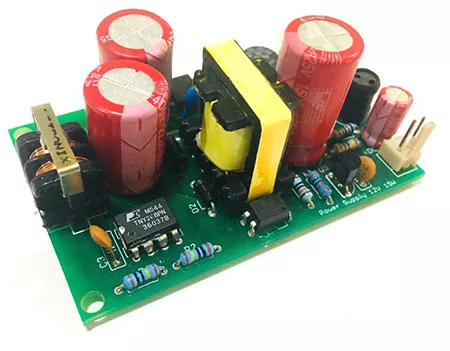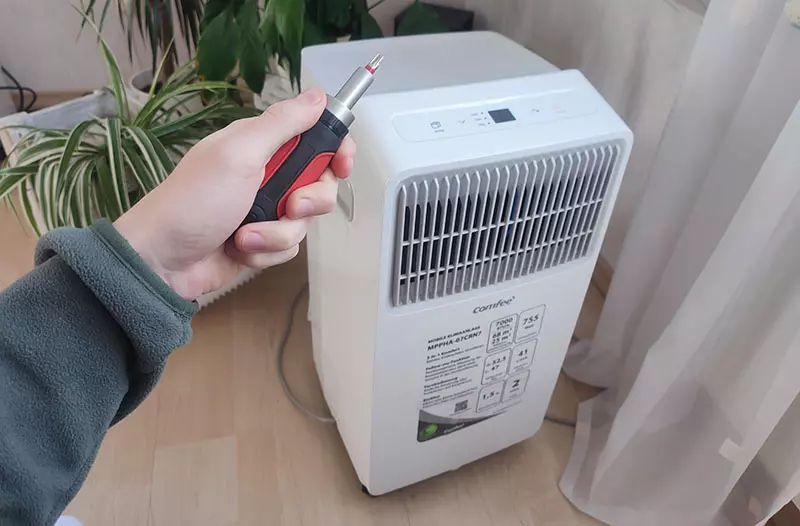Your portable AC won’t turn on? Here’s how to fix it.
Quick answer: To fix a portable AC not turning on, check fuses and circuit breakers. Ensure the wall outlet is powered. Check clogged air filters and the drain pan. Check for internal ice buildup and verify that compressor and ducts are sealed.
Don’t worry! For each of those causes, I’ll tell you exactly how to check it and which steps to take to fix it. Let’s go one by one.
Possible reasons and fixes for a portable AC not turning on
There are different possible causes for your portable AC not turning on. Here’s a list of them sorted by likelihood (first is most likely, last is least likely).
Go through the list one by one. The most important part of each list item is the “How to check” section. It helps you identify the cause of your portable AC not turning on. The “How to fix” section helps you fix it!
#1 Blown fuse or tripped circuit breaker in the electric grid
There are two spots where fuses or circuit breakers can trip: Either in the portable AC directly, or in your home’s electric grid.
The likeliest place for a fuse to trip is your home’s electric grid. It can be that your electric circuit can’t handle the portable AC’s current draw.
- How to check: Locate your home’s electric service panel and check whether a breaker tripped. Also, check for blown fuses. Maybe they are located inside the same electric service panel. But you might also have a separate fuse box (especially in older houses).
- How to fix: If a circuit breaker tripped, you can just switch it back to the ‘turned on’ position.
In case you locate a blown fuse, you first have to identify the fuse model and the amperage (it’s usually written on the casing of the fuse). Then, buy an identically rated fuse online or in a local hardware store to replace it.
Don’t worry, it’s simple. Have a quick look on YouTube, if you don’t know how to do it yet.
#2 Defective (or unpowered) wall outlet
It might be that the wall outlet you connect your portable AC to is broken.
- How to check: Connect another electronic device to the wall outlet and see if it powers on. Alternatively, move the portable AC to another wall outlet and see if it turns on there.
- How to fix: To fix a defective wall outlet, locate the right circuit breaker in your electric service panel and turn the power off first. Then, you can check the wall outlet for loose or broken connections or molten parts.
If you are not comfortable fixing a wall outlet, just hire an electrician. That’s an everyday task for them.
#3 Blown fuse or tripped circuit breaker inside the portable AC
In the power module of a portable AC, there is at least one fuse. Actually, that’s the case for every heavy-duty appliance. It might be that your specific model alternatively has a built-in circuit breaker (but that’s less likely).
Blown fuses or tripped circuit breakers inside a portable AC are not as probable, because a portable AC should never draw more power than it needs. And the circuitry inside it is designed to handle the amperage it draws.
- How to check: Unplug the portable AC from the wall outlet. Open the casing and locate the power module. Usually, it’s close to the spot the power cord connects to. The power module is an electric circuit board that looks similar to the image below.
On this power module, see if the fuse is blown. If you can’t find a fuse, look for a circuit breaker switch (which you can just switch back on). - How to fix: Replace the broken fuse. Usually, the fuse sits in a push-in system. In that case, you can just take it out. If the fuse is soldered in, you’ll need a soldering iron and solder wick to remove the fuse.
Check the amperage rating that’s engraved on the fuse and buy an identically rated replacement. Put in the new fuse to complete the fix.

#4 Clogged air filters and filled drain pan
Portable ACs need maintenance! If the air filters are clogged or the drain pan is filled, it might cause the portable AC to stop turning on. There could be safety sensors that detect water and dust buildup.
- How to check: Open the portable AC and check the air filters. Also, check the drain pan for water.
- How to fix: Clean the air filters using a dry brush (do not use water when cleaning air filters, as this will result in smelly air conditioning). Also, drain the water using the small drain pipe on the back of your portable AC.
#5 Condenser or evaporator coil filled with dirt
A condenser or an evaporator coil filled with dirt prevents a portable AC from turning on. The evaporator coil absorbs the heat from the indoor air. The condenser releases the heat from the refrigerant. A fan then blows the heat away from it. When there’s dirt on your condenser or evaporator coil, the heat absorption won’t properly work. A sensor could stop the AC from turning on due to this.
- How to check: Open your portable AC. Locate the condenser and the evaporator coil.
- How to fix: Clean the AC’s condenser and evaporator coil. I recommend this evaporator coil cleaning foam (click here to view it on amazon) for this.
#6 Ice buildup inside
If you’ve been running your portable AC on maximum settings for a few hours continuously, it might be that ice builds up inside.
The ice buildup could damage the electronic circuitry inside.
- How to check: Open your portable AC and check the area around the compressor. Do you see any ice?
- How to fix: Wait for a few hours for the ice to melt. You can also try scraping the ice off the compressor. Also, make sure that the melting ice does not drip into the electronics. After melting, wait for a few more hours to let the humidity leave the AC.
Try turning your portable AC on after it is completely dried.
#7 Broken Compressor or leaking ducts
A broken compressor or leaking ducts are the worst things that can happen to an AC. A broken compressor is hard to fix. Either you can’t open it. Or, your fix would impact the efficiency because you increase irregularities inside the compressor.
Leaking ducts can be closed, but the problem is recharging the refrigerant properly, which is better done by a professional.
- How to check: Check for visual impacts or tears in the compressor or ducts in your open portable AC. If you can’t see anything and your AC doesn’t turn on, then it’s hard to detect.
But if your AC turns on, but the compressor does not work, then you might be able to hear a hissing sound coming from the compressor or the ducts. - How to fix: Fixing a broken compressor or leaking ducts is not worth it. Instead, get a new portable AC.
What should you do if your portable AC won’t turn on?
When your portable AC doesn’t turn on, I generally recommend either getting a new portable AC or rethinking your air conditioning.
Fixing a broken portable AC is rarely worth the time and effort it takes. If the cause for your portable AC is an easy-to-fix one (such as a blown fuse), then sure, fix it!
But oftentimes, the time and effort are not worth it.
I’d say a broken portable AC is an opportunity to think about whether your next AC really has to be a portable one.
What’s a reliable AC to replace a broken portable AC?
The most reliable replacement for a broken portable AC is a window AC. In general, you should prefer window ACs over portable ACs.
The reason is that window ACs are much more efficient as they don’t have the same technical design flaws a portable AC has.
Window ACs provide up to twice the cooling capacity while still consuming about the same amount of electricity.
Window ACs don’t come with trashy hoses and you won’t need a window hose kit to install them. Also, window ACs last a lot longer.
My recommendation: Get this window AC (click here to view it on amazon) to replace your broken portable air conditioner. And care for it (no more dirt and moisture buildup).
Then, it’ll last you for decades!
However, if you need a portable AC, then check this article: 3 Most Powerful Portable Air Conditioners. It lists the (in my opinion) best and most reliable portable ACs.
Can a professional repair a broken portable AC?
Yes, a professional can repair a broken portable AC. However, a professional will usually charge you at least $100 - $200 for the fix. For old portable ACs, that’s more than the resell value.
You can also spend that money on a new AC instead.
By the way: If you are low on funds, you can also buy portable ACs used! Just look for one on eBay or craigslist and you’ll find something in your area. Maybe you can even get it with shipping.
How to safely repair a portable AC not turning on
To repair a portable air conditioner not turning on safely, you should always ensure that it’s not plugged into the wall outlet.
To reduce the risk of electric shock, leave it for a minute after unplugging it. This discharges capacitors in the electric circuitry.
In the meantime, touch a radiator, a bathtub, or a sink to discharge yourself. This prevents electric discharges from your body to the portable AC’s electronics, which can damage sensitive components.
Only then you should open the AC to check for and fix problems.
What to do if your portable AC does not work well after the fix?
If your portable AC turns on but does not work well after fixing it, I recommend replacing it with a new one.
The moisture and dirt buildup might have left permanent damage to the circuitry.
In that case, you can check once again that everything is properly cleaned (using the evaporator coil cleaner) and try running the portable AC again.
But if it still does not work, it is probably permanently damaged.
